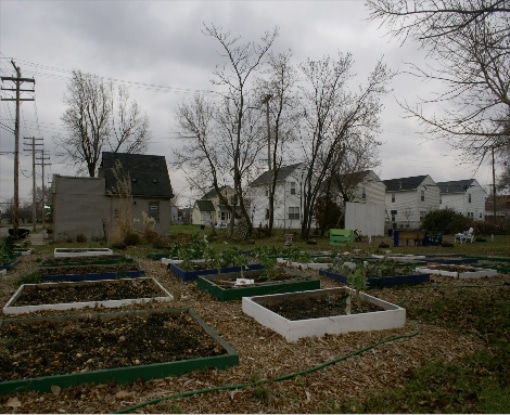When I told my friends and family I would be traveling to Detroit to write about community resilience, I got the same reaction from everyone: Silence. Then, slowly, as if not to offend me, people would look at me very seriously and say “Be very careful–you never hear anything good about Detroit. Remember, you’re a woman, you have more to lose from an attack than just your wallet.” Frequently the conversation would trail to the murder rate or economic devastation and that “desperate times make people do crazy things.” My surprise at this reaction was compounded by the fact that those words weren’t just coming from my parents, they were coming from born and bred city folks who know that the greatest cities always get a bad rap from people who have never been there.
This series of odd reactions made me more determined to go see the city for myself. I had a sneaking suspicion that Detroit was just like my beloved New York City: gritty, homey, and real in all the right places, with a community spirit missed by those just passing through.
But the voices of my friends and family warning me of the potential of physical harm did get to me. Despite being a New York City kid who has little fear of traveling alone, I have an embarrassing confession to make: I bought pepper spray. If anything dangerous really did happen I would probably clumsily spray myself in the face, so I knew that it was more about silencing the voices of concerned family and friends than it was about actual protection.
So, with my pepper spray and intuition in tow I took a trip to see what the fuss was all about.
Touching Down in Detroit
I wasn’t sure what to expect when I got off the plane and left the airport. Would I walk out to a Spartan city that, as pictures of Detroit would lead one to believe, looked like a war zone?
The moment I got into a cab I knew everything was going to be fine. I was delighted to find that just like every great city, everything you could possibly want to know can be learned from a cab driver. My cab driver, who moved to Detroit from Yemen some 10 years ago, told me that while Detroit can be a dangerous place full of racial tensions, it has become home because of the friends he’s met here and the community that has welcomed him.
After a few minutes of typical highway driving, we arrived at the Inn on Ferry Street, a collection of Victorian houses preserved by the historical society. The entire block was a magical collection of houses that took me back to a time in which barons would build 17 bedroom houses just because they could. It was a preserved snapshot of the regality of America in its heyday.
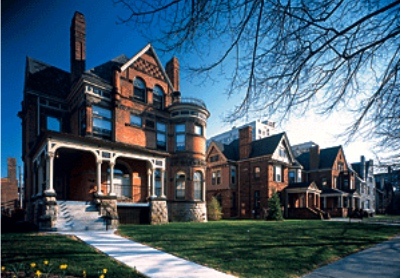
While fidgeting with my key, I met a woman named Rachel Lutz and my magical journey began. She asked me what I was doing in town. I said, with some apprehension, “writing about community resilience” She responded, “Well you’ll have to meet all of my friends.” Within 15 minutes I had the numbers of young entrepreneurs and people starting their own non profits, as well as established nonprofit and foundation types. When I expressed how overwhelming her kind gesture to a complete stranger was she said, “It’s my pleasure. So many people come here for ‘devastation porn.’ They come here to look at the abandoned buildings and devastation, but there’s something even greater here that people should be paying attention to. Right now, Detroit, and particularly this neighborhood, Midtown, is where the rebirth is being fostered by twenty-somethings who are quitting their jobs, cashing in their savings or pulling together a little capital, and going for their dreams. This is one of the few places left where if you are willing to put up a little capital, you can make your dream, whatever it is, come true. We live in the biggest small town you’ll ever experience and everyone’s ready to pick up a shovel and work with you to build the future.”
I couldn’t agree more. And for the record, I threw out my pepper spray the very next day.
So, what does this have to do with community resilience? Let me tell you.
Detroit, in a lot of ways, parallels the track we are on as a nation. After an industrial boom in the late 19th century, Detroit became a hub of commerce and a place where people could come to find opportunity. At the turn of the 20th century Detroit became synonymous with the automobile industry. As the industry branched out to become involved in city planning around car dependency, suburbanization and sprawl became a way of life.. Suburban isolation and dependence on industry are legacies we tend not to talk about in this country, but as the economy collapses, they become hard to ignore. Unresolved racial tensions and the abandonment of cities are facts of life here in the states. Let’s be clear, Detroit is not alone in this. It may be more pronounced here, but if we stay on the current track of trying to house ourselves in single family homes, consuming without regard for practicality or sustainability, and looking to a single source for our well being–in our case straight-up consumer-driven capitalism, there is no need to look into a crystal ball, the snapshot of our future is staring us in the face in the stereotypical shots of Detroit.
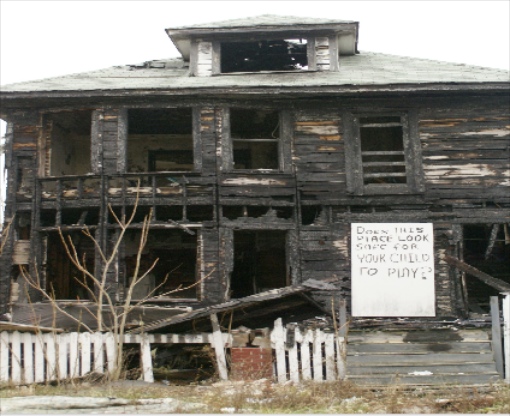
But, I believe Detroit also holds the key to the future of this great nation. We must evolve to a more sustainable way of living if we are to survive, and I think we all innately sense it. We know that two-income-dependent housing prices, while unemployment and underemployment approaches the double digits, does not add up. We know that a growing world population is not going to be able to support a group of people that consumes three times as many resources as the rest of the world. Within our lifetimes, many of us will have to find new ways to get our needs met, and pioneer a new meaning of what “the good life” really is. Those who have stayed in Detroit are pioneers. It’s like what happens to a forest after a great fire. At first glance, it looks like everything is dead. But, if you look closer you’ll find that the rich soil is fertile and ready for planting.Detroit’s ground is fertile and being seeded as you read this.
During my time there, I met with people in their 20’s and 30’s who had bought storefronts, started art collectives, started their own non-profits, and frankly, were living the dream. From the Delicious “Good Girls Go To Paris”–whose crepes are so good I wake up every morning craving them…
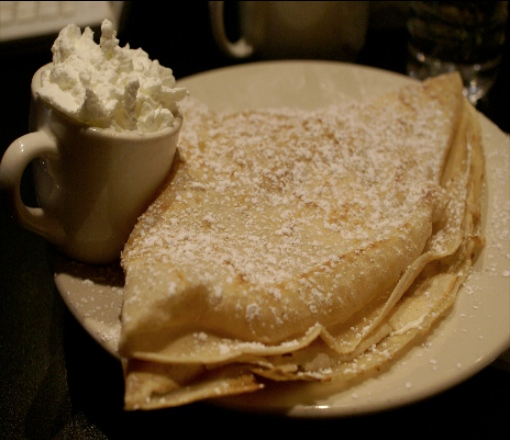
…to Rachel’s Place, a vintage store that fills an entire house in Corktown, that’s owned by Rachel Leggs.

The whole city is filled with local, frequently organic or locally made and grown things to eat, see, and enjoy. And the best part is that everyone is really into supporting these businesses. There is a dual pride that comes from supporting your friends and neighbors, and also supporting the people who, like you, want to see Detroit thrive. The local pride is as palpable as it is at a Red Sox game but it lasts much longer than a season. It made everything taste better, worth the price, and left me with a joy that box stores like H&M or Barnes and Noble never do. All the products I bought and food I ate were true quality, priced reasonably, made locally, and super cute! Imagine that.

Every business owner I talked to echoed the sentiment that their dream of owning a business could not have been fulfilled as successfully as it has been here in Detroit. One of my favorite stops during my week was to the Spiral Collective. Co-Owners Janet Jones, Dell Pryor, and Sharon Pryor (Dell’s daughter) have a shop that has gifts and house treats, a book store, and an art gallery in it. The building was once a barn in the formerly notorious Cass Corridor (Avalon Bakery is their neighbor), that was reworked by Dell into a comfortable, warm, and beautiful space. I popped in to get out of the rain and was immediately greeted, warmed, hugged, and embraced by these sweet fabulous ladies.
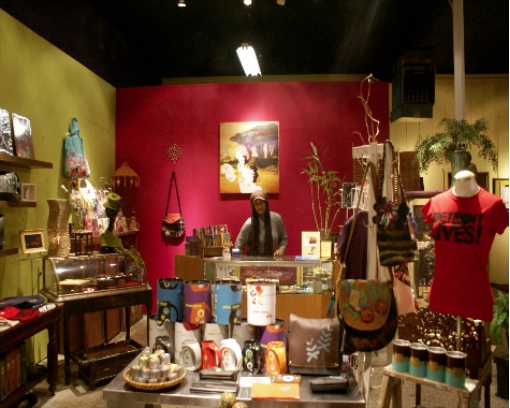


Not only did I get local art, gifts, and books at great prices, they also spoke with me about their experiences as women business owners and artists in Detroit. I felt like I got a wonderful dose of history, culture, and mentoring every time I went it. It oddly felt like home. This is the shopping experience I’ve never known I always wanted.
Projects That are Changing Detroit: Giving Young People a Voice in Defining Their City
Later in the week I met with Mike Han – Community Development Director of “I AM YOUNG DETROIT.” I met Mike while at an event on the soul of the Detroit community. While stealing a couple of the gratis muffins for lunch I overheard him explain that a city wide conversation on Detroit’s young people, their potential, and what the city has to offer them was necessary.
“I AM YOUNG DETROIT” is an effort to dispel the myths about Detroit, and highlight the cool, progressive, creative work being done by the under 40 set in the city. It not only highlights events, news, and culture of the city, it also puts the spotlight on the emerging creative class, artists, designers, musicians, and entrepreneurs who are hustling to great success in the city.
Mike is a young entrepreneur himself, with his blog and brand called Street Culture Mash (https://streetculturemash.com/blog/), which is a lifestyle brand that is meant to compliment a more sustainable and creative lifestyle. SCM offers sustainable art in tangible goods with everything from organic apparel to furniture to fixed gear bikes. I had already drank the “I love Detroit” cool-aid by the time I got to sit down with him, but talking about the challenges and potential of this great city was like getting an IV of love for this city that is refillable any time I visit either of his sites. Mainly we spoke about what a great city Detroit is for young folks, artists, and creative types, and the spirit of helping each other. “Basically, people are excited if you’re excited in Detroit. If you want to do something good, people are like, “I can help with that” or “Do you know so and so?” Because we’re like a small town, people are well connected and willing to use those connections to help you pursue your dream.”
We also talked about local city government. The city has been rocked with a history of political corruption and there are very real suburban vs. urban issues which have their roots in racial tensions. 8 mile road continues to be the physical barrier between the largely African American city and mostly white suburbs. White flight which contributed to the city’s loss of jobs and tax revenue, and the well documented discrimination that kept blacks from moving into the suburbs has lead to resentment on both sides with regards to planned revitalization of the city. On the one hand, the city and the suburbs need each other. They need the ideas, people power, and investment of industries that moved their operations to the suburbs. On the other hand, it makes sense that some Detroit residents find it insulting that suburban people who have chosen to abandon the city, send their kids to private schools, and live in communities protected by police forces, would want to have a hand in deciding what the future of the city should be. There is also a palpable fear in Detroit that once revitalization does happen, gentrification will follow, and once again those who rebuilt the city will have to leave once white, upper class people deem it a posh place to live. As someone who has worked in community development, I hesitated to share this story because I worry that Detroit will become synonymous with places like San Francisco or Williamsburg – places in which “redevelopment” and “revitalization” really means pushing out low to moderate income people and people of color. But my hope is that there are enough citizens within Detroit committed to the re-envisioning process early on that will fight with the same fervor they have for years, to keep the city theirs. With the introduction of Mayor Bing (who has both supporters and opponents, naturally) and the “Detroit Works Project”, which has invited citizens to actively be involved in the city’s re-envisioning process, civic engagement, while heated, is also clearly a priority. Almost 1,000 people turned out for the first public meeting to discuss strategies from the consolidation of neighborhoods to the possibility of more public transportation in this historically car driven city. As Mike said:“We may have a shortage of some things, but one thing there isn’t a shortage of is passion for this city”.
Putting Community Development in the Hands of the Community
Later that night some new friends invited me to Soup at Spaulding in North Corktown. A creative funding initiative started by local community members. The community meets every Thursday to eat a simple, beautiful, and delicious meal of soup (made from ingredients from the community garden Spirit Farm and donations from Avalon Bakery), buy local produce (fresh eggs, jams, and beautiful produce), and learn about two community projects that need funding. The 5 dollar admission covers the cost of your meal and goes to whatever project the group votes on. The projects then go up on KickStarter to get more funding. That night, a woman named Danielle “Doxie” Kaltz, who started the Detroit chapter of a service arm of Burning Man called Burners Without Borders, presented about a project she created after seeing homeless folks living under bridges. She has been packing backpacks full of blankets, toiletries, food, and anything else people might need, and driving around and giving them out to those experiencing homelessness. She won the pot that night. The room was electrified with the brave and humble efforts of Doxie, who simply saw a need and decided to have the audacity to fill it. But hey, clearly, that’s the Detroit way.
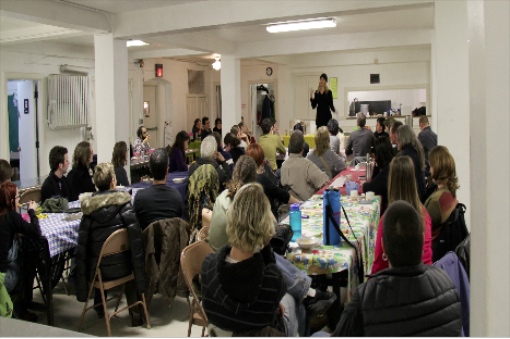
Building Healthier more Connected Community, One Seed at a Time
On one of my last days in the city I met Mark Covington, founder of the Georgia Street community collective who after getting laid off from his job as an environmental engineer and moving back into his family’s home, noticed that people were dumping in the empty lots across from his house. “I knew no one else was going to clean those lots, so I decided I would” he says with a shrug, as if it were simply the logical thing to do. After cleaning the lots only to have them dumped at again, he decided to plant a garden to prevent re-dumping. Not only did it work, but community members began to come out of their houses to see what he was up to. Neighborhood kids began to help with the planting and become interested in gardening, and people, who sensed a connectedness with Mark, began to share their difficulties with affording food while paying for heating and electricity. This spurred Mark to begin to grow more and involve the community. In time he developed an outdoor movie night, a “read to your kids” night, and community celebration nights.

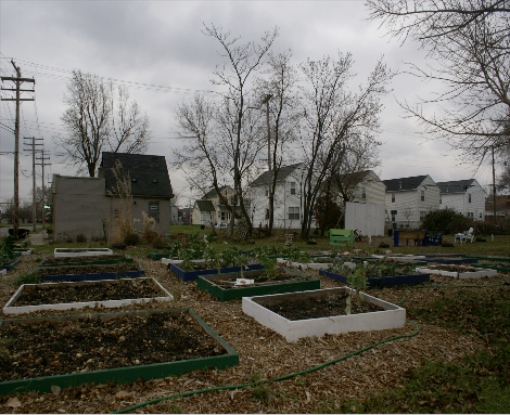
He bought the building next to his grandmother’s house for next to nothing and he and his brother are doing all the renovations. They hope to have a space to have more community dinners and celebrations, a computer lab for the kids, a clothing and food donation drop off space, and an emergency fund for community members experiencing tough times. The whole collective now consists of 5 lots on Georgia Street, including a fruit orchard. Talk about community resilience. Detroit is the embodiment of the DIY movement.
Giving Students a Chance to Design the Future
And the institutions of the town, the College for Creative Studies (CCS) and Wayne State University, as well as both community and global foundations are taking notice and picking up a shovel as well. Amazing strides are taking place with University/Foundation partnerships that are funding business incubators, light rail development projects, partnership development, and grants that allow entrepreneurs, researchers, scientists, tech industry folks, and artists to live in the city while connecting them to communities in need. The College for Creative Studies has even sent its students out into Detroit to think creatively about how art and design can foster community development. One project in particular, CCS student Veronika Scott’s “Element Survival Coat” has garnered national attention. After spending time in homeless shelters Veronika designed of a stylish coat, lined with house insulation that is water proof and self heated that can be turned into a sleeping bag at night. It can be sown by someone with no prior experience and will hopefully be given at no cost to those who need it. The hope is to empower those experiencing homelessness by employing them to sew the coats and providing them with free housing and meals in addition to a paid job. You can learn more about the initiative here.
“I really think it’s a blessing that we’ve been deconstructed. We just have to build it right this time. If we do, we can show the world how to live in a sustainable way, with a city that can move quickly to adapt to whatever changes comes its way” said Mike. I couldn’t agree more.
So, here’s my final confession: I want to move to Detroit. Having lived in New York City, D.C, Boston, and now, San Francisco, I’m used to comfortable city life that caters to the young. But never have I experienced a place thriving with talent, energy, passion, and determination to make their city, and by association, the world, a better place. If you are looking for a place to develop your dream, whatever it may be, consider trying to do so in Detroit, in the place I am now dubbing the birthplace of our collective new American destiny. See you there.
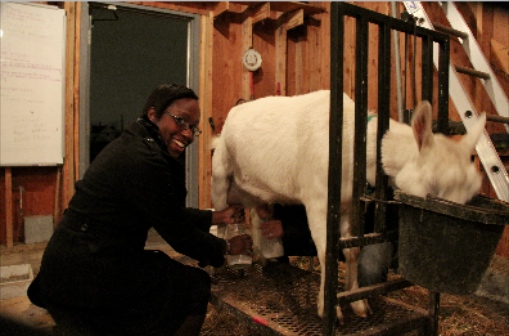
##
This essay appear in Shareable’s paperback Share or Die published by New Society, available from Amazon. Share or Die is also available for Kindle, iPad, and other e-readers. For the next piece in Share or Die, Robin’s “Every Guest A Host” click here.
